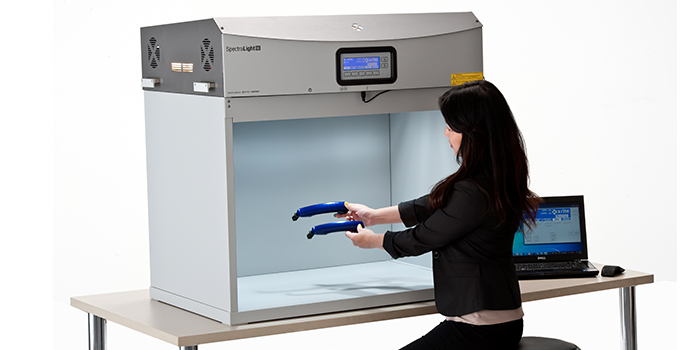The Future of Sustainable Color Evaluation: Embracing LED Lighting Technology In today's rapidly evolving world, sustainability in manufacturing has become more than just a buzzword; it's a necessity. As industries strive to reduce their environmental footprint, the importance of sustainable practices in manufacturing cannot be overstated. This shift towards sustainability not only benefits the planet but also enhances business operations, leading to long-term success and resilience. The ...
The Need for Industry Standards for Visual Color Evaluation in Retail LED Lighting In the retail industry, lighting is a critical factor that influences how products are perceived by customers. However, the lack of standardized LED lighting poses significant challenges that can impact both retailers and consumers. Inconsistent Color Reproduction One of the primary issues with the absence of standardized LED lighting is inconsistent color reproduction. Different LED lights can produce varying co...
5 Things That Could Go Wrong Without an Automotive Spectrophotometer An automotive spectrophotometer is a critical tool in the automotive industry, especially when it comes to automotive color control. These advanced devices ensure that paint colors are precisely matched, consistently applied, and meet the required standards for automotive finishes. Without an automotive spectrophotometer, several issues can arise that impact the quality, efficiency, and overall satisfaction of vehicle paint jo...
Moving from Fluorescent to LED Light Booths for Color Evaluation: How the EU’s Ban Drives Innovation
The Future of Color Consistency: LED Lighting Solutions for Industry Standards For years, fluorescent bulbs have been a mainstay in industries requiring accurate color assessment, but their downsides are becoming increasingly hard to ignore. These lights require warm-up time and may distort color accuracy, both of which lead to production delays and translate into higher sample costs. More importantly, fluorescent bulbs contain hazardous materials like mercury, complicating their disposal...
Why Backward Compatibility in Spectrophotometers Is Key to Consistent Color If you’re here, chances are you rely on a benchtop spectrophotometer to keep your color quality on point. From textiles and plastics to paint, coatings, and more, these high-precision instruments are critical to maintain consistency in your processes. At X-Rite, we engineer our spectrophotometers to perform reliably for years, even in the toughest environments. But no instrument lasts forever, and eventually, an ...
Looking for a centralized location to manage your X-Rite products and services? Check out My X-Rite. Whether you need product information or support, service details, or access to learning resources, our free online portal is just a few clicks away. 24/7 Access: Easily access your personal dashboard from your computer or mobile device around the clock. Personalized Dashboard: See what matters most to you in one convenient location. Effortless Service & Support: Submit and track...
A recent amendment to the EU Directive on the restriction of the use of certain hazardous substances in electrical and electronic equipment will remove the current exemption for mercury to be used in a number of types of fluorescent lamps for special purposes by 24th of February 2025. These bulbs are defined under clause 2(b)(4)-I of the EU REACH directive. After the expiration date, the sale of new equipment including fluorescent technology under this exemption will not be allowed in Europe. Th...
Enhancing Automotive Aesthetics with Automotive Color Match In today's fast-paced automotive industry where innovation is the driving force, the demand for precision and perfection has never been higher. Automotive designers and manufacturers are constantly seeking ways to enhance vehicle aesthetics, while parts manufacturers and refinishers strive to match color and appearance between parts and across sites. The Significance of Automotive Color Matching The right automotive paint color not onl...
Does your quality control program include visual evaluation? If not, it should. Using the SpectraLight QC as part of a color evaluation workflow. No matter your industry, judging color is more than just measuring samples with a color measurement device. Just because a spectrophotometer says your color is within tolerance, doesn’t necessarily mean it will look right to the human eye. To minimize customer rejects, your color control process needs to include visual evaluation in a light boo...
This time of year, the internet is full of Top 10 Countdowns. It’s a tradition we’ve embraced since 1940 when the Billboard published its first chart ranking the top selling recorded songs. Since then, others have jumped on the bandwagon to highlight the most popular trends of the previous year. We’ve been publishing our top-read blogs since 2016, and we’re happy to see some educational topics like color perception, tolerancing, and spectrophotometers continue to r...
Why Calibrate Your Spectrophotometer? For the most part, today’s color measurement instruments are 100% digital. In fact, there are very few analog components inside, except for the light bulbs. Although they’re more stable than their analog predecessors, their tolerances are much narrower, and they need regular spectrophotometer calibration to stay within these tight specs. Bulb Stability As you use your instrument and the bulb turns on and off, it starts to change its character. S...
You say color is important, but do you know why it’s so important? In reality, color is a critical element in the manufacturing process. Unfortunately, many manufacturers are realizing that getting color right is much harder than it used to be, and the brands they support are asking them to meet tighter tolerances. Here’s why. While advances in color technology – think metallic packaging, pearlescent finishes, custom fabrics and vibrant new colors – entice customers, the...
When customers are just getting started with color management, they often ask, "What is the difference between a spectrometer and a spectrophotometer?". With such a minute spelling difference, it's easy to make a quick typo and get the wrong answer for this color question. So...what's the difference? Spectrometers vs. Spectrophotometers What is a Spectrophotometer? A spectrophotometer is a color measurement device that is used to capture and evaluate color on just about anything, in...
In this series we’ve been discussing the many factors that impact how we see color, and what we can do to ensure the color we see is accurate. Light, retinal fatigue and background effects can influence our perception of color. Today we’ll look at the limitations of the human eye and brain, and talk about how to detect these characteristics, especially for individuals responsible for evaluating and judging color. Are YOU color deficient? Read on to find out. (Spoiler alert: There’s a test at the...
There are many things that affect our ability to see color. In some cases, it doesn’t matter if the red you see is the same shade I see. A barn is a barn, right? But for those who work in an industry where color evaluation is part of the job, it IS important… VERY important. In our color perception series, we’re discussing the many factors that affect how we see color and what colorists can do to ensure that the color they see is the color they are supposed to see. Today we’ll take a closer look...
As the temperature of light changes, so does our perception of color. As I mentioned in our last post, light plays a huge role in the way we perceive color. Today we’ll look at the science of color in manufacturing and photography; specifically how an object’s reflective and absorptive properties and viewing technology can impact the colors we perceive. To reflect or not to reflect… that is the question. The colors an object absorbs and reflects is determined by its material – is it metal, plas...
How many trial and error steps does it take you to formulate a color? If you answered more than three, it might be time to enlist the help of a computerized solution. Computer-aided color formulation can bring huge benefits to your business. Out of the gate, even beginners can hit color targets faster, saving time, money and expensive colorants. Once you have established an accurate method, you can expect to match 95% of your color formula requirements within a reasonable color distance on the f...
According to autolist.com, over 80% of cars produced today are white, black, or some shade of gray. It’s not necessarily because bright and bold colors are more difficult to produce and match than their grayscale counterparts, they just take longer to get through the inspiration and car design process. Believe it or not, producing a new auto color can take up to five years before it makes it to the showroom floor. It’s a long, tedious process for designers, paint...
There are many things that affect what we see. Optical illusions aren’t just fascinating; they teach us about how we visually perceive our surroundings. In our Color Perception Series, we shared some of the factors that affect how we see color and the impact it has on manufacturing. In honor of April Fools' Day, we’re taking a closer look at some of the ways our brain, eyes, and the environment can influence what we see. April Fool #1: Your Brain Let’s start with the power of t...
Each year we enjoy looking back to see what our customers enjoyed reading. Here are our top blogs and learning resources from 2021. Top Blogs of 2021 Some of these blogs make the top 10 list every year. Do any interest you? Color Perception Part 1: The Effect of Light This first blog in a 3-part series offers a non-technical explanation to the way we perceive color, and the role of light in color perception. How to Calibrate your Monitor in 10 Steps Are ...












.jpeg?h=285&la=en&w=400&hash=6F4520F30E11DA92838E11C8E55C4BFB32664563)







